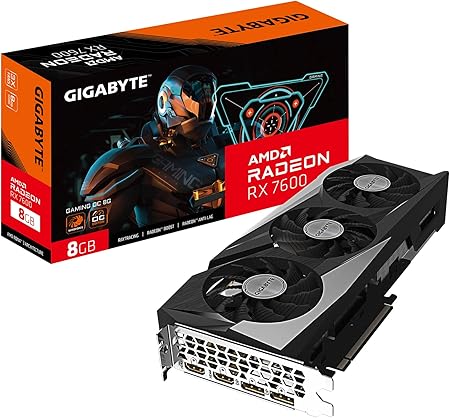GIGABYTE Radeon RX 7600 OC 8GB

The GIGABYTE Radeon RX 7600 OC 8GB is a powerful graphics card designed for gaming, featuring a 128-bit GDDR6 memory and an impressive 8GB of VRAM. With a boost clock speed of up to 2755 MHz and support for high resolutions up to 7680x4320, it is built to deliver stunning visuals and smooth performance in demanding applications.
Popularity: Medium
Performance:
Specifications:
Name GPU: GIGABYTE Radeon RX 7600 OC 8GB
Graphic Engine:
Cores: 2048
Core Clock: Boost Clock: up to 2755 MHz, Game Clock: up to 2355 MHz
Vram: 8GB
Memory Clock: 18 Gbps
Memory Type: GDDR6
Memory Bus: 128 bit
Power Consumption: 165.0 W
Power Connectors: 8 pin*1
RGB: no
PCI Express: PCI-E 4.0
Max Resolution: 7680x4320
DirectX: 12 Ultimate
OpenGL: 4.6
Dimensions: L=282 W=115 H=50 mm
PCB Form: ATX
Output: DisplayPort 1.4a *2, HDMI 2.1a *2
Manufacturer Page: Link
Review
The GIGABYTE Radeon RX 7600 OC 8GB graphics card represents a strategic inclusion in the AMD lineup, bringing the RDNA 3 architecture to the sub-$300 segment. For those in search of a budget-friendly GPU, this offering is noteworthy, albeit with some compromises.
Technical Specifications and Features
- Architecture: RDNA 3 based on the Navi 33 chip
- Performance: 21.5 TFLOPS FP32 throughput
- Core Clock: Up to 2755 MHz
- Memory: 8GB GDDR6 on a 128-bit bus with a bandwidth of 288 GBps
- Output Ports: DisplayPort 1.4a x2, HDMI 2.1a x2
- Power Consumption: 165W with a single 8-pin power connector
- DirectX and OpenGL Support: DirectX 12 Ultimate and OpenGL 4.6
This graphics card is specifically designed for 1080p gaming, providing decent performance, especially in this price range (Tom's Hardware). However, it utilizes a monolithic die approach rather than chiplets, which could potentially limit future advancements.
Performance Analysis
In accordance with its RDNA 3 lineage, the GIGABYTE Radeon RX 7600 OC 8GB achieves notable FP32 and FP16 throughput improvements. Despite the theoretical advancements in compute performance, the real-world gains are sometimes modest, particularly when compared to the much more robust RTX 4070 from NVIDIA (Tom's Hardware).
The card delivers standard frame rates ranging between 80 to 120 fps at high settings for 1080p gaming but falls short when pushed to 1440p, necessitating a reduction in quality settings (CNET). AMD's FidelityFX Super Resolution (FSR) 2.0 technology offers performance improvements, but it's more relevant for select titles known to optimize for it. Forza Horizon 5, for instance, may experience low-memory-related warnings at 1440p on AMD cards due to suboptimal utilization of the available VRAM (Ars Technica).
Comparative Analysis
Compared to its direct competitor, the NVIDIA RTX 3060, the GIGABYTE Radeon RX 7600 OC 8GB stands toe-to-toe in some benchmarks, while lagging significantly in ray-tracing tasks (CNET). However, AMD holds a slight edge in certain professional tasks per the SpecViewPerf benchmarks. It seems to be more suited for users who prefer traditional rasterized performance over next-gen graphical effects.
Pros and Cons
- Pros:
- Cost-effective for 1080p gaming
- Generous VRAM at 8GB GDDR6
- Decent FP32 performance increase with RDNA 3
- Cons:
- Underwhelming ray tracing performance
- Struggles with higher resolution gaming (1440p and above)
- Lacks the ongoing advancements provided by GPU chiplets
Conclusion
The GIGABYTE Radeon RX 7600 OC 8GB holds its ground as a viable option for gamers focused on mainstream titles at 1080p. It offers competitive specifications at an affordable price. While it remains an attractive proposition for those restricted to a sub-$300 budget, users aiming for higher resolutions or better ray tracing should consider alternatives, such as NVIDIA's offerings or even future iterations from AMD itself. Its importance may hinge on affordability and utility in a landscape often marred by inflated prices and extreme options.